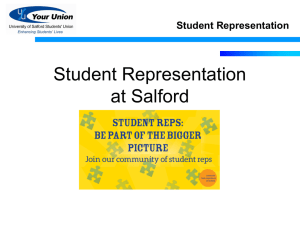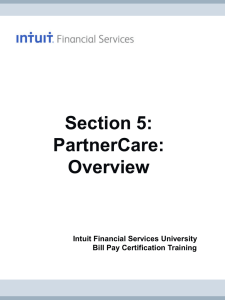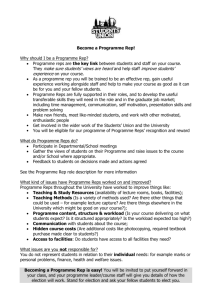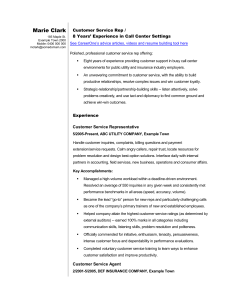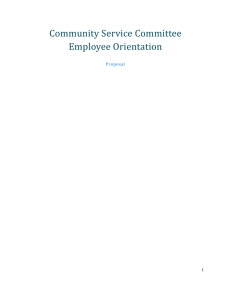Lecture 22
advertisement
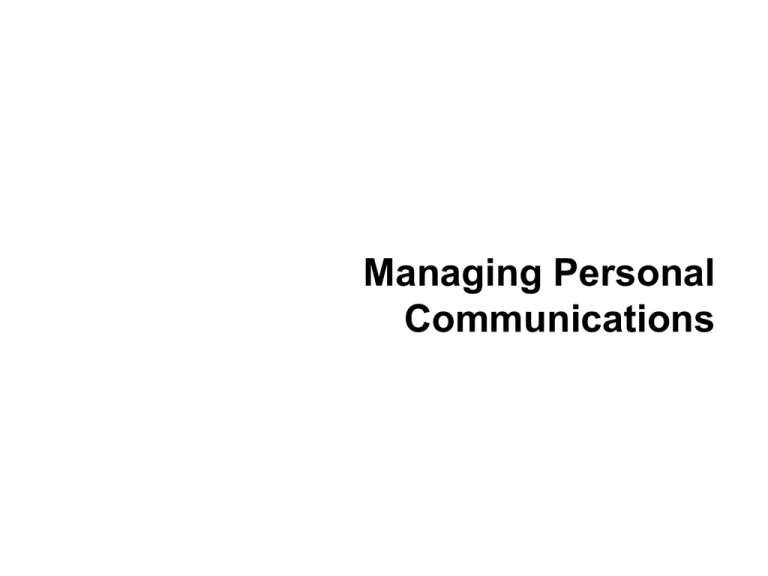
Managing Personal Communications WORD OF MOUTH • Consumers use WOM to share information on products and services ‒Positive WOM may be generated organically but may be managed and facilitated. ‒Paid Media results from press coverage of company generated advertising WORD OF MOUTH ‒Earned Media – also called Free Media, is all the PR benefits a firm receives without having directly paid for anything. Not really free as firm invests in products, services and marketing, but expense are not devoted to eliciting a media response. WORD OF MOUTH • Social Media ‒Means for consumers to share information ‒Useful but cannot be sole source of marketing communication ‒Three main platforms for social media: Online Communities and Forums – may be formed by consumers with no affiliations or by firms WORD OF MOUTH Blogs are regularly updated online journals or diaries. Brings people together based on common interests. Consumers create most but some are created by firms. FTC requires disclosure from bloggers if they have a relationship with marketers. Social Networks – consumers looking to connect with others. Current popular networks are Facebook, LinkedIn and Twitter WORD OF MOUTH • Buzz and Viral marketing try to showcase by creating a splash in the marketplace. ‒Buzz Marketing generates excitement, creates publicity, and conveys new relevant brand-related information through unexpected or outrageous means. WORD OF MOUTH ‒Viral Marketing is another form of wordof-mouth or “word-of-mouse” that encourages consumers to pass along company-developed products and services or audio, audio video, or written information to others online Opinion Leaders Opinion Leaders – society contains cliques and members of each clique tend to interact frequently which facilitate communication but also insulates the clique from new ideas. Malcom Gladwell identifies three factors working to ignite public interest in an idea: Opinion Leaders • Reach the three types of people who can spread an idea like an epidemic, mavens or knowledgeable people, connectors who know and communicate and salesman who possess persuasive power • “Stickiness” or expressing and idea so it motivates people to act • “The Power of Context” controls whether those spreading an idea are able to organize groups and communities around it. Measuring the effects of Word-ofMouth (WOM) • Intuit classified blogs into several categories velocity, share-of-voice (how much talk occurred), voice quality (what was said and to what positive or negative degrees), and sentiment (how meaningful were the comments) • Researcher Keller Fay notes that 80% of WOM occurs offline but many marketers focus on easy-to-track online efforts Sales Representative Types • Types of Sales representatives - six positions ‒Deliverer – major task is delivery of product ‒Order taker- inside or behind counter, outside which goes out and makes calls ‒Missionary – do not take orders but build relationships ‒Technician – serve as a knowledge resource Sales Representative Types ‒Demand creator – use creative skills to sell tangible goods ‒Solution Vendor – Consultative selling by providing solutions to solve the customer problem Personal Selling and Relationship Marketing • Personal Selling steps appropriate for transaction situations • relationship Marketing steps required to build long-term customer relationship and ensuing loyalty Company must develop sales force objectives, strategy, structure, size and compensation. Sales Force Objectives and Strategy • Objectives - tasks to perform include prospecting, targeting, communicating, selling, servicing, information gathering, and allocating • Strategy - approach can be sales rep to buyer, sales rep to buyer group, sales team to buyer group, and conference selling or seminar selling. A company can utilize a direct (company) or contractual (outside) sales force Sales Force Objectives and Strategy • Direct sales force – full or part-time sales representative that work directly for the selling firm • Contractual sales force – external partners who work on commission (e.g. manufacturers’ reps, sales agents, brokers) Sales Force Structure • Territorial – use when selling one product line to one end-using industry with customers in many locations • Product – use when selling many products to many types of customers • Market – option similar to product structure Sales Force Structure • Example - Motorola uses four types of sales force structure: strategic market, geographic, distributor sales force focusing on distributors and an inside sales force using inbound and outbound telemarketing. Some companies categorize their large and valuable customers as strategic accounts and create a strategic account management team to manage each of these types of customers. Sales Force Size • Group customers into size classes according to sales volume • Establish call frequencies (# of account calls per year) • Multiply # of accounts in each size class by call frequency to arrive at total workload, in sales calls per year • Determine average # of calls a sales rep can make per year • Divide total annual calls (calculated in step 3 above) by the average annual calls made by a rep (calculated in step 4 above) to see number of reps needed Sales Force Compensation • Fixed compensation ‒ Salary satisfies need for income stability ‒ Common in jobs with a high ratio of non-selling to selling duties and jobs here the selling task is complex and requires teamwork • Variable Amount ‒ Commissions, bonus, profit sharing, serve to stimulate and reward effort ‒ Works best where sales are cyclical or depend on individual initiative ‒ Attracts High performers, but they may emphasize selling at the expense of the relationship Sales Force Compensation • Expense Allowances - Enable sales reps to meet expenses of travel and entertainment • Benefits – such as paid vacations provide security and job compensation • Combination plans feature benefits of both while limiting their disadvantages Managing Sales Force • What makes a good sales representative? One survey shows 25% of reps generate 52% of sales • Average sales rep turnover for all industries s almost 20%. Turnover leads to: ‒ Lost sales ‒ Expense of finding new replacements ‒ Increase pressure on existing reps to pick up slack Managing Sales Force • Recruitment procedures ‒ Solicit names from existing reps, agencies ‒ Recruit from colleges ‒ Length of time and expense varies by organization ‒ Universities are collaborating with firms as they develop sales training programs within their curriculum Training and Supervising Sales Representatives • Median training period is 28 weeks in industrial – products firms, 12% in service firms, 4% in consumer-products ‒Goals - to know and identify with the company, to know the company’s products, to know the customers’ and competitors’ characteristics ‒Other goals - to know how to make effective sales presentations, and to understand field procedures and responsibilities Sales Rep Productivity • Norms for customer calls • Norms for prospect calls • Using sales time efficiently ‒ Time and duty analysis/improving productivity ‒ Inside sales force • Due to rising cost of outside sales force • Rising automation (for inside and outside sales forces) Sales Rep Motivation • Motivating Sales Representatives - the higher the sales person’s motivation, the greater his or her effort ‒Sales quotas ‒Supplementary motivators (meetings, contests, etc.) Sales Rep Evaluation • Evaluating Sales Representatives • Sources of information - sales reports including activity plans and write-ups of activity reports • Formal evaluation - current-to-past sales comparisons, customersatisfaction evaluation, and qualitative evaluation Sales Rep Evaluation • Key indicators of sales performance ‒ Average # of sales calls per rep per day ‒ Average sales call time per contact ‒ Average revenue per sales call ‒ Average cost per sales call ‒ Entertainment cost per sales call ‒ Percentage of orders per hundred sales call number of new customers per period ‒ Number of lost customers per period ‒ Sales force cost as a percentage of sales • Performance may also be related internal factors (effort, ability, strategy) and external factors (task and luck) Thank you
